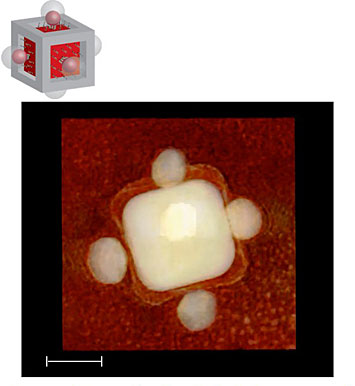LEGO™ Construction of Nanoparticle Assemblies
April 24, 2019
 enlarge
enlarge
Tomographic reconstruction (bottom) of programmed assembly of a nanoarchitecture built by selected attachment of spherical particles to the six flat faces of a gold nanocube, and its corresponding scheme (top). The scale bar represents 50 nanometers.
What is the scientific achievement?
CFN users from the University of Chicago developed a new method of selectively attaching DNA strands to specific regions of nanoparticles, which in turn dictate how the components assemble into more complex architectures. The team used this approach to demonstrate an unprecedented variety of nanoarchitectures — 24 in total.
Why does this achievement matter?
This research demonstrates the use of surface functionalization to achieve new levels of complexity of nanomaterial assembly. The method’s versatility will facilitate in-depth studies of interactions between particles of different sizes, shapes, and compositions within the nano-assemblies.
What are the details?
Surface encoding of colloidal nanoparticles with DNA is fundamental for fields where recognition interaction is required, particularly controllable material self-assembly. However, regioselective surface encoding of nanoparticles is still challenging because of the difficulty associated with breaking the identical chemical environment on nanoparticle surfaces. This work demonstrates the selective blocking of nanoparticle surfaces with a diblock copolymer (polystyrene-b-polyacrylic acid). By tuning the interfacial free energies of a ternary system involving the nanoparticles, solvent, and copolymer, controllable accessibilities to the nanoparticles’ surfaces are obtained.
Through the modification of the polymer-free surface region with single-stranded DNA, regioselective and programmable surface encoding is realized. The resultant interparticle binding potential is selective and directional, allowing for an increased degree of complexity of potential self-assemblies. The versatility of this regioselective surface encoding strategy is demonstrated on various nanoparticles of isotropic or anisotropic shape and a total of 24 distinct complex nanoassemblies are fabricated. This effort was greatly aided by the use of the CFN Microscopy facilities, where the scientists were able to unambiguously show the 3-dimensional structures of the most complex self-assemblies.
CFN Capabilities:
The CFN Electron Microscopy facility was used to obtain a series of TEM images for 3D visualizations and analysis by tomographic reconstructions.
Publication Reference
G. Chen, K.J. Gibson, D. Liu, H.C. Rees, J.H. Lee, W. Xia, R. Lin, H.L. Xin, O. Gang, Y. Weizmann, Regiospecific surface encoding of nanoparticles for programmable self-assembly, Nature Materials 18, 169 (2019).
DOI: 10.1038/s41563-018-0269-0
Acknowledgement of Support
This work is supported by the University of Chicago and the NSF CAREER Award (DMR-1555361) to Y.W. D.L. acknowledges the Martha Ann and Joseph A. Chenicek Graduate Research Fund and HHMI International Student Research Fellowship. This research used resources of the Center for Functional Nanomaterials at Brookhaven National Laboratory, which is supported by US DOE Office of Science Facilities under Contract DE-SC0012704. O.G. gratefully acknowledges the support by the US Department of Energy, Office of Basic Energy Sciences, Division of Materials Sciences and Engineering under grant no. DE-SC0008772.
2019-15531 | INT/EXT | Newsroom









